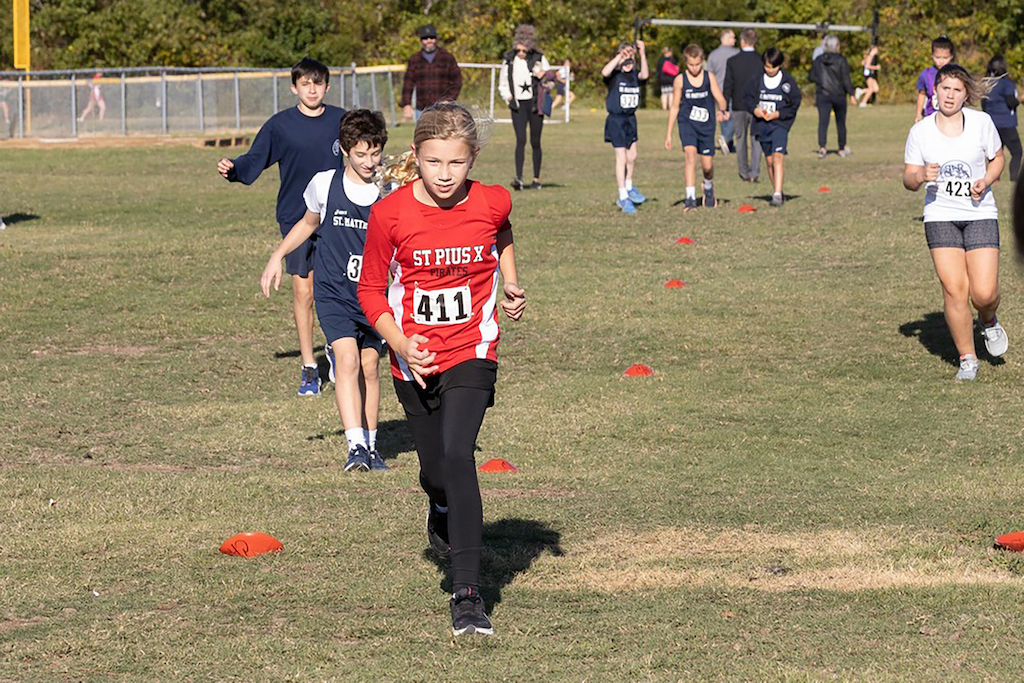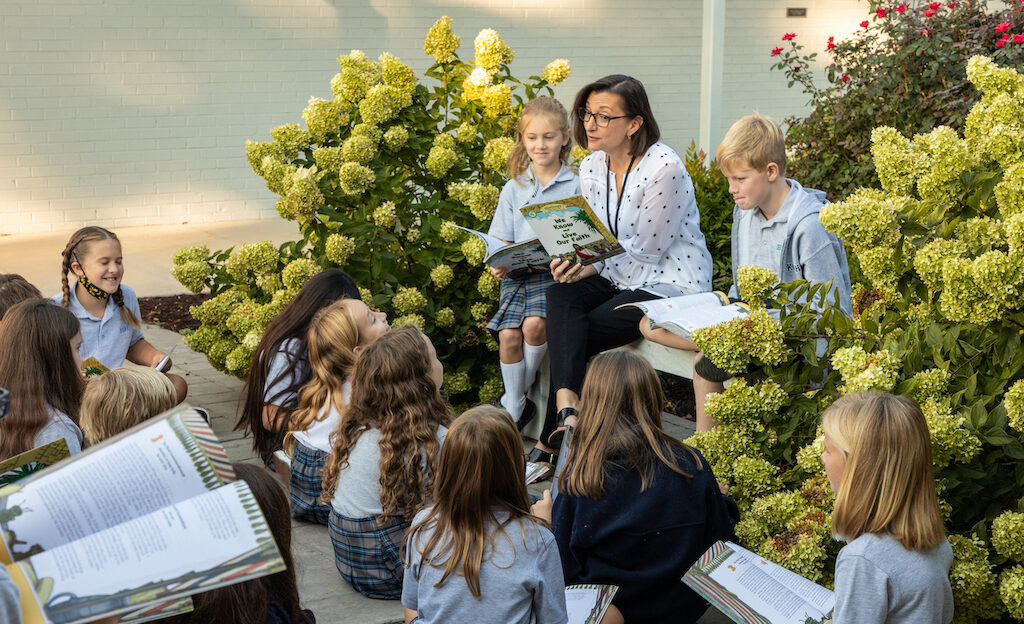Special collection planned in support of Catholic schools’ Learn to Lead campaign
Providing quality Catholic education to as many students as possible is a sacred responsibility – that’s the belief of the diocese’s Learn to Lead fundraising campaign, which provides financial aid to students at its Catholic schools.
Learn to Lead was developed in 2021 in response to the surge in enrollment during the pandemic. Parents were looking for an alternative to virtual or closed public schools, but some couldn’t afford the cost of Catholic school.
“Many families came to us during the pandemic knowing that we could provide a top-notch, in-person educational experience,” said interim Superintendent of Schools Jennifer Bigelow. “Families stayed because they recognized the value proposition of our schools: the authentic development of the whole child – mind, body, and spirit.”
Bishop Barry C. Knestout worked closely with then-Superintendent of Schools Kelly Lazzara and Margaret Keightley of the Catholic Community Foundation (CCF) to outline the campaign’s goals. The initiative seeks to raise $30 million over the next decade for various efforts to prepare student leaders, retain teachers, and enhance financial aid.
The bishop is asking all parishes to take a special collection for Learn to Lead at Masses the weekend of Sept. 30-Oct. 1.
Joyce Schreiber, director of CCF’s McMahon Parater Scholarship Foundation, said, “The goal of our tuition assistance programs is to help ensure that every family who wants a Catholic education for their child is not prevented from doing so because of the tuition cost. We encourage every family to apply for tuition assistance rather than assume that they will not be able to afford to go to a Catholic school.”
Schreiber explained that the diocese received 3,718 applications for tuition assistance for the 2022-2023 school year. The need came to a total of $16,552,484. Thanks in large part to the Learn to Lead campaign, the diocese raised $11,045,128. Even though it fell short of the amount needed, it was still the highest amount ever raised.
Confidence in Catholic schools
John Williams attended All Saints, Richmond, from junior kindergarten through 8th grade, and credits his time there as one of the reasons he now works as a NASA engineer. He said his family’s connection to Catholic schools goes back generations.
He said his grandparents were worried about the state of Richmond public schools back in the 1950s, after the 1954 Brown v. Board of Education U.S. Supreme Court ruling that said all public schools were to integrate. They decided to send their children to Van De Vyver school, a Catholic school in Richmond that has since closed.
Williams said Catholic schools in the diocese were already integrated at that time, and were a refuge for Black families. “My family’s history and confidence with Catholic education in Richmond was cemented through all the perils of both the pre-civil rights era and the integration and civil rights era,” said Williams.
Williams’ mother, uncles, and aunts all attended Catholic school, as did Williams and his two sisters. He treasured his experience, saying, “The moral and religious foundation was critical. I would not have received that guidance elsewhere. I was encouraged to see and engage with the world through faith in Christ.”
“This has helped me persevere in multiple personal and professional struggles throughout my lifetime. Without that foundation, I would be lost,” said the NASA engineer. Williams now works to inspire the next generation and recently revisited his alma mater to teach the students about his work with NASA on the Artemis II mission to the moon.
Ryan Crawford is another recent alumnus of the diocese’s Catholic schools. A graduate of Sacred Heart, Danville, Crawford is now a student at Columbia University. Crawford said he was deeply affected by the tight-knit Sacred Heart community. For ten years, he said he took advantage of the small class sizes and individual attention that allowed him to excel in both his academic and spiritual life.
“Besides a stellar education, I believe Catholic school presents a more worldly perspective that allows one to question and develop their own beliefs,” said Crawford.
In middle school, unfortunate events forced Crawford’s family to seek financial aid so Crawford could remain in the school he loved. “I was extremely appreciative that with the assistance of the diocese I was able to continue my education,” he said.
Marissa Jimenez’s parents immigrated to Norfolk from the Philippines and the entire family found a spiritual sanctuary in the Catholic community at St. Pius X Catholic School, Norfolk.
Jimenez and her three brothers were students there, while their mother was a kindergarten teacher for decades. Jimenez’s two sons, both of whom received academic scholarships, are current students, as are various extended family members.
“Because Catholic schools focus on the whole child, school wasn’t just about teaching academics, but also teaching students how to pray, think, lead, collaborate, and serve,” said Jimenez.
“They focused on strengthening the intellectual, mental, and social health of students, all of which are important in developing well-rounded adults who can work together and contribute positively to our communities,” she added.
“I’m not suggesting that students who receive a Catholic education won’t have obstacles or challenges along the way,” Jimenez said, “but alongside a supportive community, they’d be well-equipped to handle the ups and downs with grace and the courage to move forward even in hard times.”

Catholic school conversions
Melissa and Charles Sikorski’s children also attend St. Pius X. The family was not Catholic and had turned to Catholic school during the pandemic. It was not their plan to convert to Catholicism, but after becoming part of the school community, they decided to become part of the faith community as well.
“It was incredible how welcoming Principal Zafra and the rest of the St. Pius community was to our family,” said Charles.
The Sikorskis were impressed with how the St. Pius X teachers stepped up to help their children, and every child, based on their individual needs.
“I think Catholicism provides an excellent framework for children when it comes to learning how to treat and care for others, work together, listen to others, and solve problems; they are learning how to be a part of a larger community. It is not all about the individual,” Melissa said.
“When I look at our culture today and the inability of people to listen to each other, find common ground, or work together, it’s depressing. At St. Pius X, we all choose to be there and share common goals in spite of our individual differences. I think the religious background provides that added structure that is missing elsewhere,” she said.
Of the benefits of Catholic education, Bigelow stated, “Catholic school students across the country outperformed public and charter school counterparts on the National Assessment of Educational Progress (NAEP) last year.”
“The congressionally mandated “report card” on academic progress confirmed what we and parents across the diocese know,” said Bigelow. “Our schools are committed to an outstanding education and our students and teachers rise to the challenge.”
Editor’s notes:
- If you would like to donate, visit learntoleadcampaign.org
- To apply for financial assistance, please visit https://discovercatholicschools.org/enroll/affording-a-catholic-education/
- To learn more about the EISTC tax credit program, visit https://richmonddiocese.org/eistc/

